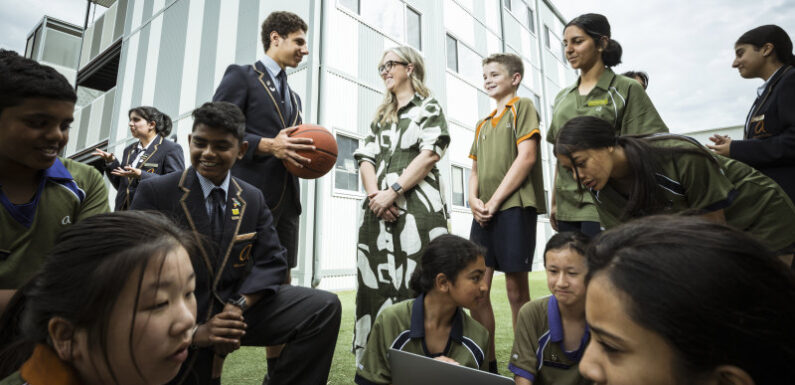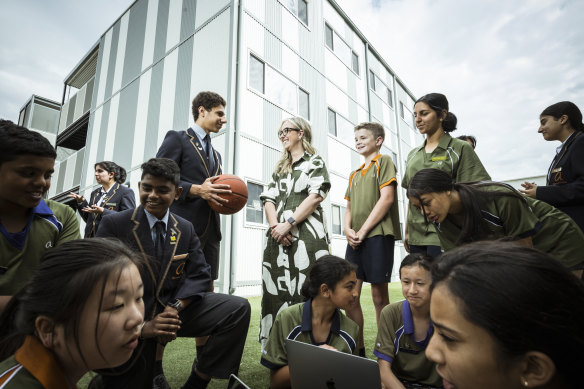
Save articles for later
Add articles to your saved list and come back to them any time.
The number of schools in Victoria with 2000-plus thousand students has more than doubled in the past decade, posing a challenge for school leaders to make sure students have enough space to learn and strong enough social connections to avoid getting lost in the crowd.
School profile data from the Australian Curriculum, Assessment and Reporting Authority (ACARA) shows that the number of Victorian schools with 2000 or more total enrolments jumped from 13 in 2012 to 34 in 2022.
Acting principal of Alamanda College – Felicity Mayes – with year 6-9 student captains and house leaders. The school had grown to more than 3000 students since opening in 2013. Credit: Chris Hopkins
Several of the campuses to hit the 2000 mark in recent years are located in Melbourne’s surging growth corridors in the west and south-east.
The student population at Alamanda K-9 College in Point Cook, in Melbourne’s outer west, has rocketed since the campus opened in 2013, hitting 3351 in 2022.
Acting principal Felicity Mayes said the school had worked hard to turn its surging student numbers, which could be viewed as a negative, into a positive, noting that larger enrolments mean the school can offer a broader range of activities.
“It’s enabled us to run extra programs and think outside the box for opportunities that we can offer our students.”
Space is tight and the school is “going up” to manage it, with three-storey portable classrooms brought in so that single level ones can be removed to free up more room in the schoolyard. At the same time, the college is thinking about how its students can learn off-campus, expanding its range of off-site programs.
“We have a rigorous outdoor education program across the college – we have a sailing school attached to it, where we take the kids down to Wyndham Harbour,” Mayes said.
The school runs seven different timetables to manage the flow of students, but Mayes believes the school’s organisational structure is the most important thing to make sure all students have a point of contact with teachers they know well.
Assistant principals and head teachers oversee smaller groups of the college’s students, so they can get to know them better.
“Everyone wants to feel like we know who their child is and what their needs or concerns are,” Mayes said.
More Victorian schools look set to join the list of 2000-plus enrolments in coming years, with several campuses creeping towards that milestone and 56 schools enrolling between 1500 and 2000 students in 2022.
Cranbourne East Secondary College principal Meagan Cook said her school, which had 1829 enrolments last year, will likely peak at around 2100 students within the next few years.
Cook said sufficient space was one of the biggest challenges for the college, which recently decided to split its lunchtime timetable to reduce congestion in the yard during breaks.
“We can’t bring our whole school community together in any one space,” she said.
Independent school Bacchus Marsh Grammar has also seen soaring student numbers, with enrolments climbing from 1523 in 2012 to 3262 in 2022.
Principal Andrew Neal said families often worried about sending children to larger schools, but said if set up properly big schools could offer smaller ‘hubs’ where students could build community.
“If it is properly structured, you can have smaller units… micro units, where students are known,” he said.
Grattan Institute education programs director Jordana Hunter said that when managed well, larger schools can provide benefits to both teachers and students.
“They do have the benefit of providing a much richer set of opportunities for students — and a wider suite of extracurricular activities across sport and drama and clubs,” she said.
“Teachers get to work in larger faculties and there’s an opportunity for shared planning.”
But Hunter noted that principals of large campuses need the leadership training and support so that they can effectively manage the many moving parts of schools with thousands of students.
“I do think governments need to get better at recognising the levels of complexity in the role.”
The Morning Edition newsletter is our guide to the day’s most important and interesting stories, analysis and insights. Sign up here.
Most Viewed in National
From our partners
Source: Read Full Article
